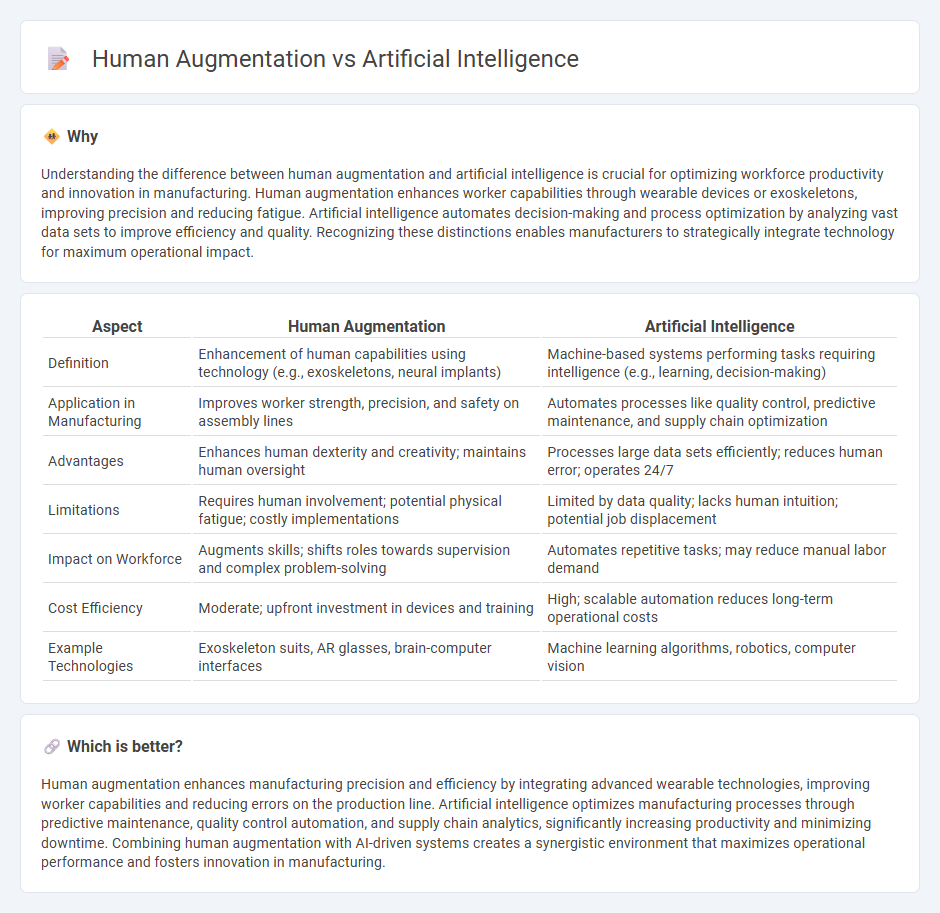
Human augmentation enhances workforce capabilities by integrating advanced cybernetic devices and wearable technologies, boosting productivity and precision in manufacturing processes. Artificial intelligence leverages machine learning algorithms and automation to optimize manufacturing operations, reduce errors, and predict maintenance needs efficiently. Explore how these transformative innovations reshape the future of manufacturing.
Why it is important
Understanding the difference between human augmentation and artificial intelligence is crucial for optimizing workforce productivity and innovation in manufacturing. Human augmentation enhances worker capabilities through wearable devices or exoskeletons, improving precision and reducing fatigue. Artificial intelligence automates decision-making and process optimization by analyzing vast data sets to improve efficiency and quality. Recognizing these distinctions enables manufacturers to strategically integrate technology for maximum operational impact.
Comparison Table
| Aspect | Human Augmentation | Artificial Intelligence |
|---|---|---|
| Definition | Enhancement of human capabilities using technology (e.g., exoskeletons, neural implants) | Machine-based systems performing tasks requiring intelligence (e.g., learning, decision-making) |
| Application in Manufacturing | Improves worker strength, precision, and safety on assembly lines | Automates processes like quality control, predictive maintenance, and supply chain optimization |
| Advantages | Enhances human dexterity and creativity; maintains human oversight | Processes large data sets efficiently; reduces human error; operates 24/7 |
| Limitations | Requires human involvement; potential physical fatigue; costly implementations | Limited by data quality; lacks human intuition; potential job displacement |
| Impact on Workforce | Augments skills; shifts roles towards supervision and complex problem-solving | Automates repetitive tasks; may reduce manual labor demand |
| Cost Efficiency | Moderate; upfront investment in devices and training | High; scalable automation reduces long-term operational costs |
| Example Technologies | Exoskeleton suits, AR glasses, brain-computer interfaces | Machine learning algorithms, robotics, computer vision |
Which is better?
Human augmentation enhances manufacturing precision and efficiency by integrating advanced wearable technologies, improving worker capabilities and reducing errors on the production line. Artificial intelligence optimizes manufacturing processes through predictive maintenance, quality control automation, and supply chain analytics, significantly increasing productivity and minimizing downtime. Combining human augmentation with AI-driven systems creates a synergistic environment that maximizes operational performance and fosters innovation in manufacturing.
Connection
Human augmentation enhances workers' physical and cognitive abilities through wearable technologies and implants, enabling improved efficiency in manufacturing processes. Artificial intelligence integrates with these augmentations by providing real-time data analysis, predictive maintenance, and adaptive control systems that optimize production workflows. Together, human augmentation and AI create a synergistic environment that boosts precision, reduces errors, and accelerates decision-making in smart factories.
Key Terms
Automation
Automation driven by artificial intelligence (AI) enhances efficiency by performing repetitive tasks with precision and speed, surpassing human capabilities in data processing and decision-making. Human augmentation integrates AI technologies to extend physical and cognitive abilities, enabling users to interact seamlessly with automated systems. Explore the evolving impact of automation on both AI and human augmentation to understand future workforce dynamics.
Cobots (Collaborative Robots)
Cobots (Collaborative Robots) enhance human augmentation by working alongside humans to improve productivity, safety, and precision in tasks across manufacturing, healthcare, and logistics. Unlike traditional artificial intelligence systems that operate independently, Cobots integrate AI with human collaboration, enabling seamless interaction and adaptive learning in real-time environments. Discover how Cobots are revolutionizing industries by combining artificial intelligence with human capabilities for optimized performance.
Decision Support Systems
Decision Support Systems powered by artificial intelligence enhance data analysis, pattern recognition, and predictive modeling beyond human capabilities, enabling faster and more accurate decision-making in complex scenarios. Human augmentation integrates AI-driven tools directly with human cognitive functions, improving real-time judgment and adaptability by combining machine precision with human intuition. Explore the nuances and practical applications of AI and human augmentation in Decision Support Systems to understand their complementary roles in optimizing organizational decisions.
Source and External Links
What Is Artificial Intelligence (AI)? | Google Cloud - Artificial intelligence (AI) is a set of technologies enabling computers to perform advanced functions such as understanding language, analyzing data, and making recommendations, primarily through machine learning and deep learning.
Artificial intelligence - Wikipedia - AI refers to the ability of machines to perform tasks typically requiring human intelligence, including learning, reasoning, and decision-making, and encompasses various subfields and applications from virtual assistants to autonomous vehicles.
Artificial Intelligence (AI): What it is and why it matters - SAS - AI allows machines to learn from data, adjust to new inputs, and perform human-like tasks using technologies like machine learning, neural networks, and deep learning, with applications in image recognition, speech processing, and natural language understanding.
 dowidth.com
dowidth.com